Training & Development Impact on Customer Service in Malmaison Hotel
VerifiedAdded on 2023/04/21
|21
|6212
|369
Literature Review
AI Summary
This literature review examines the impact of training and development on customer service within the hospitality industry, focusing on four-star hotels, particularly through a case study of Malmaison Newcastle. It covers the concepts of training and development, customer satisfaction, and relevant theories such as reinforcement, experiential learning, cognitive learning, constructive learning, and connectivism. The review highlights the necessity of training in the hospitality sector for maintaining competitiveness, meeting organizational needs, and enhancing business performance. It also addresses factors affecting training and development, the impact of training quality on employee performance, and the subsequent effect on customer satisfaction, emphasizing the importance of skilled and knowledgeable staff in delivering quality services and ensuring customer loyalty. The review concludes by underscoring the role of training in addressing challenges, meeting quality standards, and fostering employee development.
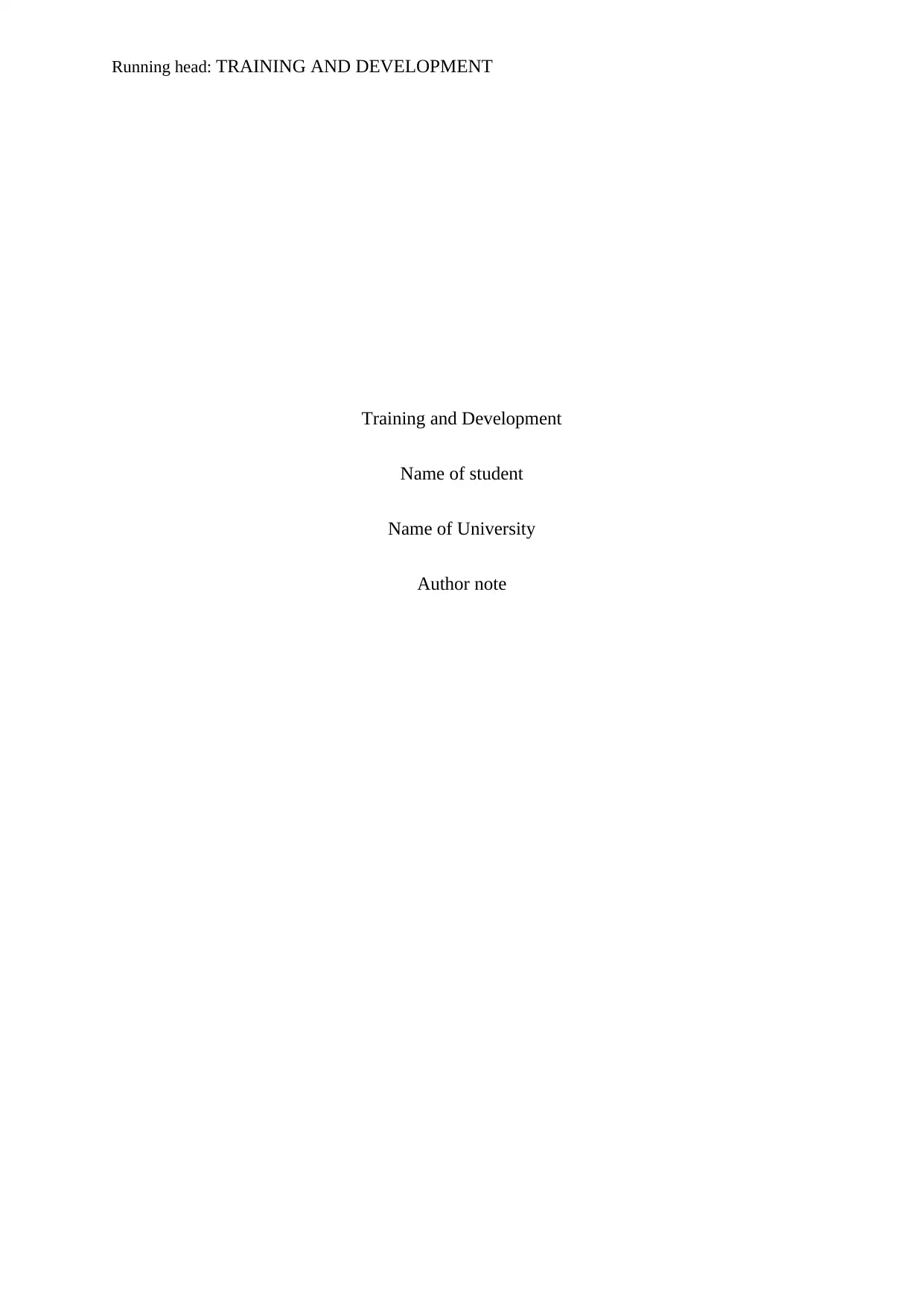
Running head: TRAINING AND DEVELOPMENT
Training and Development
Name of student
Name of University
Author note
Training and Development
Name of student
Name of University
Author note
Paraphrase This Document
Need a fresh take? Get an instant paraphrase of this document with our AI Paraphraser
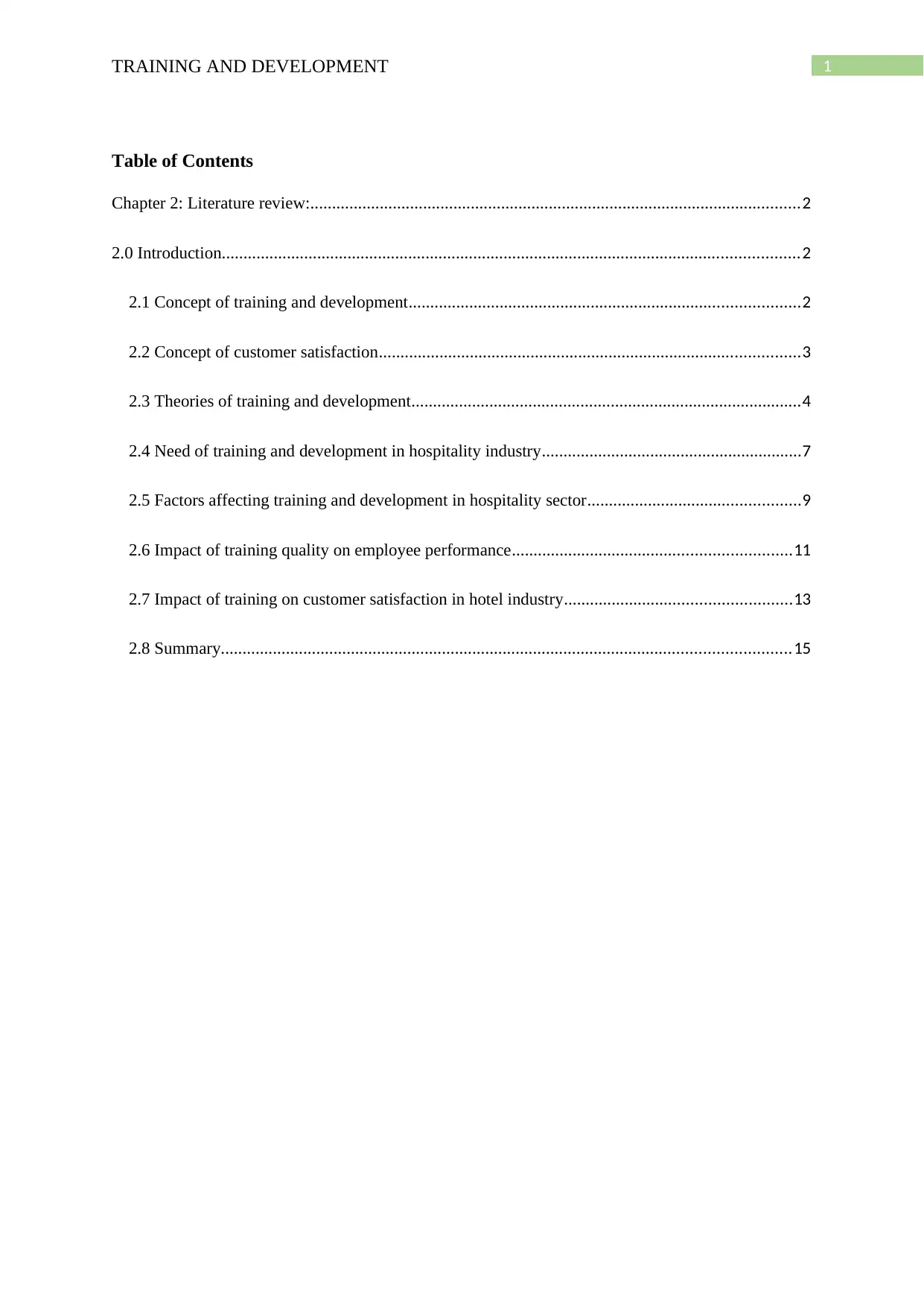
1TRAINING AND DEVELOPMENT
Table of Contents
Chapter 2: Literature review:.................................................................................................................2
2.0 Introduction.....................................................................................................................................2
2.1 Concept of training and development..........................................................................................2
2.2 Concept of customer satisfaction.................................................................................................3
2.3 Theories of training and development..........................................................................................4
2.4 Need of training and development in hospitality industry............................................................7
2.5 Factors affecting training and development in hospitality sector.................................................9
2.6 Impact of training quality on employee performance................................................................11
2.7 Impact of training on customer satisfaction in hotel industry....................................................13
2.8 Summary...................................................................................................................................15
Table of Contents
Chapter 2: Literature review:.................................................................................................................2
2.0 Introduction.....................................................................................................................................2
2.1 Concept of training and development..........................................................................................2
2.2 Concept of customer satisfaction.................................................................................................3
2.3 Theories of training and development..........................................................................................4
2.4 Need of training and development in hospitality industry............................................................7
2.5 Factors affecting training and development in hospitality sector.................................................9
2.6 Impact of training quality on employee performance................................................................11
2.7 Impact of training on customer satisfaction in hotel industry....................................................13
2.8 Summary...................................................................................................................................15
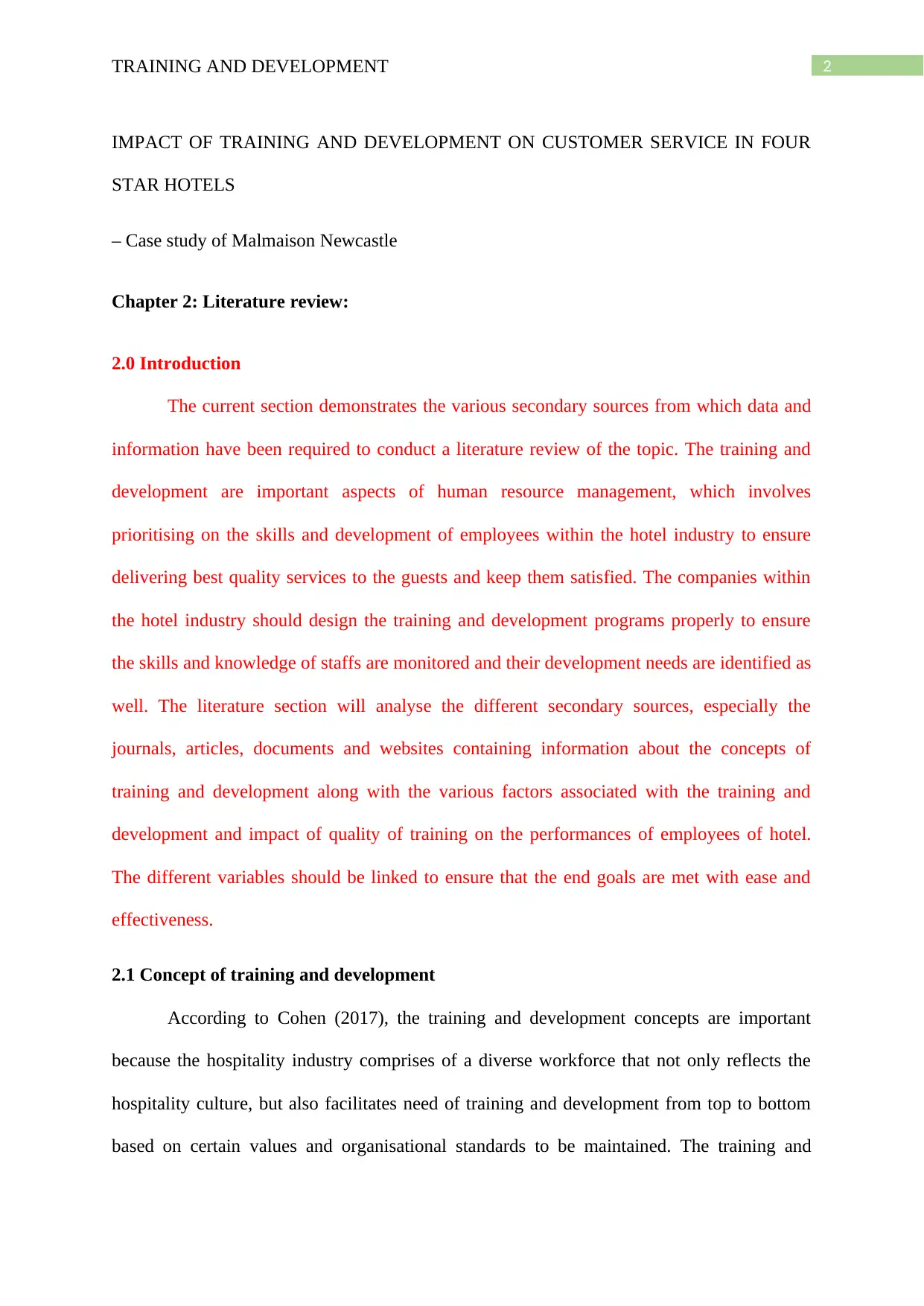
2TRAINING AND DEVELOPMENT
IMPACT OF TRAINING AND DEVELOPMENT ON CUSTOMER SERVICE IN FOUR
STAR HOTELS
– Case study of Malmaison Newcastle
Chapter 2: Literature review:
2.0 Introduction
The current section demonstrates the various secondary sources from which data and
information have been required to conduct a literature review of the topic. The training and
development are important aspects of human resource management, which involves
prioritising on the skills and development of employees within the hotel industry to ensure
delivering best quality services to the guests and keep them satisfied. The companies within
the hotel industry should design the training and development programs properly to ensure
the skills and knowledge of staffs are monitored and their development needs are identified as
well. The literature section will analyse the different secondary sources, especially the
journals, articles, documents and websites containing information about the concepts of
training and development along with the various factors associated with the training and
development and impact of quality of training on the performances of employees of hotel.
The different variables should be linked to ensure that the end goals are met with ease and
effectiveness.
2.1 Concept of training and development
According to Cohen (2017), the training and development concepts are important
because the hospitality industry comprises of a diverse workforce that not only reflects the
hospitality culture, but also facilitates need of training and development from top to bottom
based on certain values and organisational standards to be maintained. The training and
IMPACT OF TRAINING AND DEVELOPMENT ON CUSTOMER SERVICE IN FOUR
STAR HOTELS
– Case study of Malmaison Newcastle
Chapter 2: Literature review:
2.0 Introduction
The current section demonstrates the various secondary sources from which data and
information have been required to conduct a literature review of the topic. The training and
development are important aspects of human resource management, which involves
prioritising on the skills and development of employees within the hotel industry to ensure
delivering best quality services to the guests and keep them satisfied. The companies within
the hotel industry should design the training and development programs properly to ensure
the skills and knowledge of staffs are monitored and their development needs are identified as
well. The literature section will analyse the different secondary sources, especially the
journals, articles, documents and websites containing information about the concepts of
training and development along with the various factors associated with the training and
development and impact of quality of training on the performances of employees of hotel.
The different variables should be linked to ensure that the end goals are met with ease and
effectiveness.
2.1 Concept of training and development
According to Cohen (2017), the training and development concepts are important
because the hospitality industry comprises of a diverse workforce that not only reflects the
hospitality culture, but also facilitates need of training and development from top to bottom
based on certain values and organisational standards to be maintained. The training and
⊘ This is a preview!⊘
Do you want full access?
Subscribe today to unlock all pages.

Trusted by 1+ million students worldwide
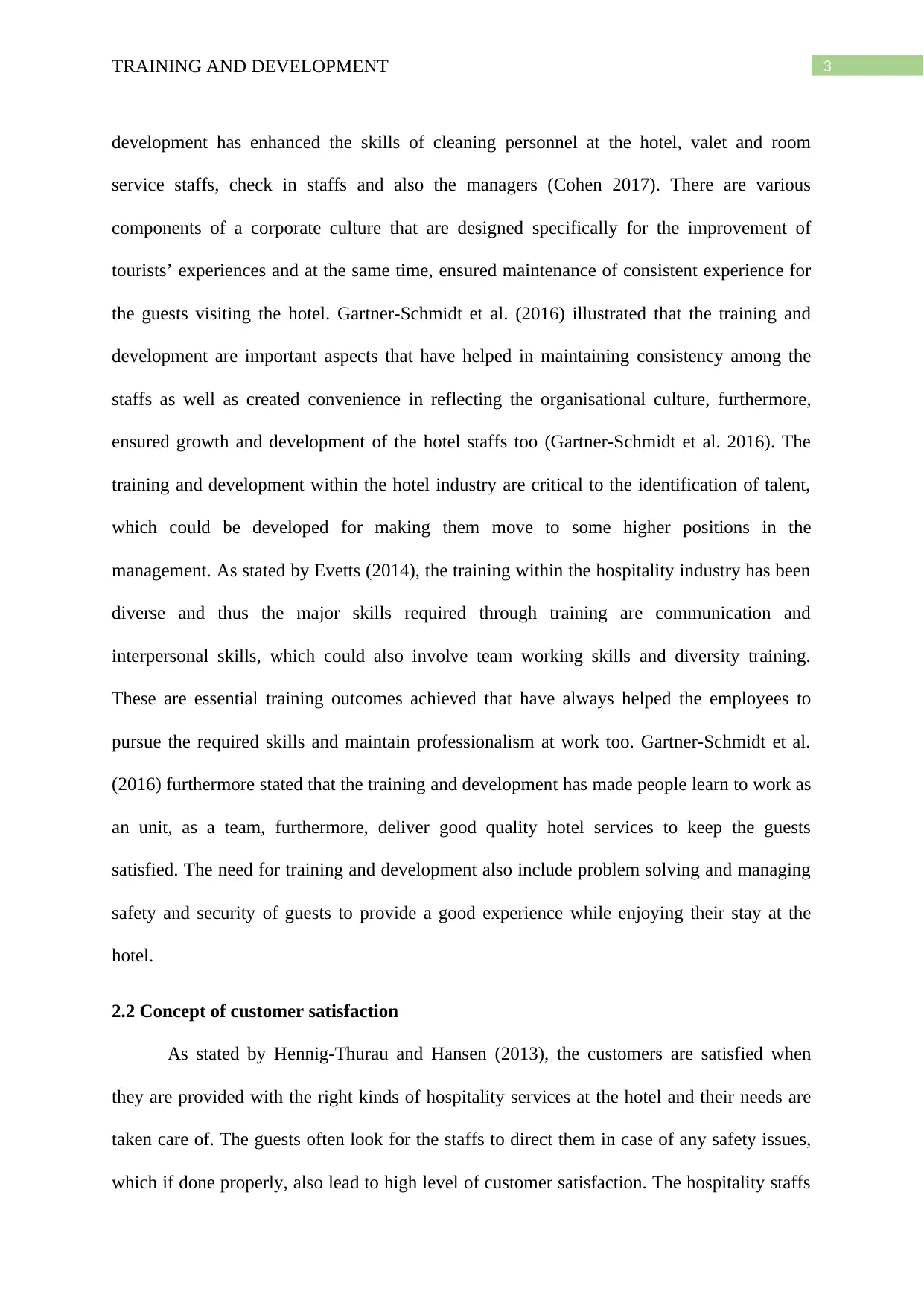
3TRAINING AND DEVELOPMENT
development has enhanced the skills of cleaning personnel at the hotel, valet and room
service staffs, check in staffs and also the managers (Cohen 2017). There are various
components of a corporate culture that are designed specifically for the improvement of
tourists’ experiences and at the same time, ensured maintenance of consistent experience for
the guests visiting the hotel. Gartner-Schmidt et al. (2016) illustrated that the training and
development are important aspects that have helped in maintaining consistency among the
staffs as well as created convenience in reflecting the organisational culture, furthermore,
ensured growth and development of the hotel staffs too (Gartner-Schmidt et al. 2016). The
training and development within the hotel industry are critical to the identification of talent,
which could be developed for making them move to some higher positions in the
management. As stated by Evetts (2014), the training within the hospitality industry has been
diverse and thus the major skills required through training are communication and
interpersonal skills, which could also involve team working skills and diversity training.
These are essential training outcomes achieved that have always helped the employees to
pursue the required skills and maintain professionalism at work too. Gartner-Schmidt et al.
(2016) furthermore stated that the training and development has made people learn to work as
an unit, as a team, furthermore, deliver good quality hotel services to keep the guests
satisfied. The need for training and development also include problem solving and managing
safety and security of guests to provide a good experience while enjoying their stay at the
hotel.
2.2 Concept of customer satisfaction
As stated by Hennig-Thurau and Hansen (2013), the customers are satisfied when
they are provided with the right kinds of hospitality services at the hotel and their needs are
taken care of. The guests often look for the staffs to direct them in case of any safety issues,
which if done properly, also lead to high level of customer satisfaction. The hospitality staffs
development has enhanced the skills of cleaning personnel at the hotel, valet and room
service staffs, check in staffs and also the managers (Cohen 2017). There are various
components of a corporate culture that are designed specifically for the improvement of
tourists’ experiences and at the same time, ensured maintenance of consistent experience for
the guests visiting the hotel. Gartner-Schmidt et al. (2016) illustrated that the training and
development are important aspects that have helped in maintaining consistency among the
staffs as well as created convenience in reflecting the organisational culture, furthermore,
ensured growth and development of the hotel staffs too (Gartner-Schmidt et al. 2016). The
training and development within the hotel industry are critical to the identification of talent,
which could be developed for making them move to some higher positions in the
management. As stated by Evetts (2014), the training within the hospitality industry has been
diverse and thus the major skills required through training are communication and
interpersonal skills, which could also involve team working skills and diversity training.
These are essential training outcomes achieved that have always helped the employees to
pursue the required skills and maintain professionalism at work too. Gartner-Schmidt et al.
(2016) furthermore stated that the training and development has made people learn to work as
an unit, as a team, furthermore, deliver good quality hotel services to keep the guests
satisfied. The need for training and development also include problem solving and managing
safety and security of guests to provide a good experience while enjoying their stay at the
hotel.
2.2 Concept of customer satisfaction
As stated by Hennig-Thurau and Hansen (2013), the customers are satisfied when
they are provided with the right kinds of hospitality services at the hotel and their needs are
taken care of. The guests often look for the staffs to direct them in case of any safety issues,
which if done properly, also lead to high level of customer satisfaction. The hospitality staffs
Paraphrase This Document
Need a fresh take? Get an instant paraphrase of this document with our AI Paraphraser
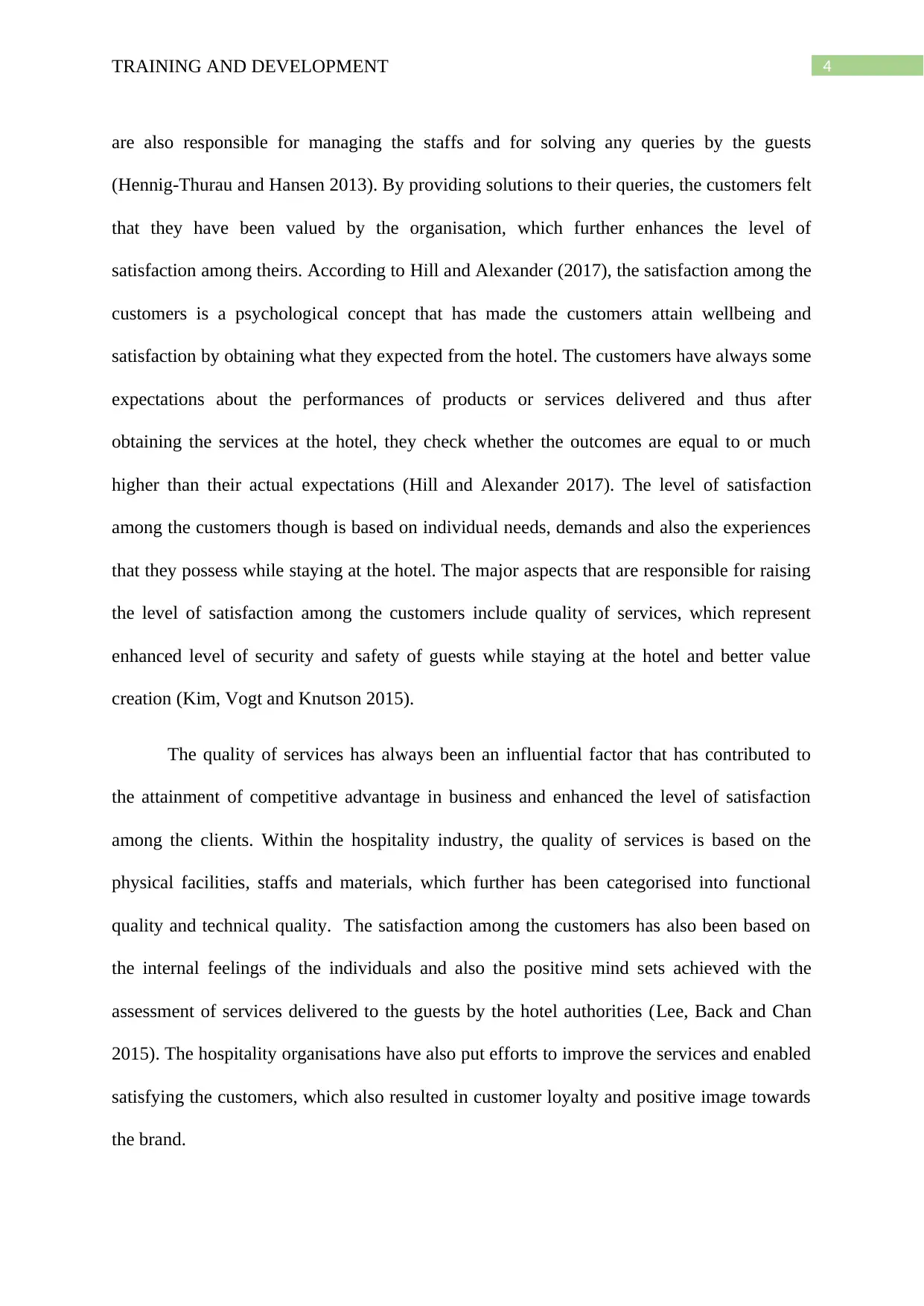
4TRAINING AND DEVELOPMENT
are also responsible for managing the staffs and for solving any queries by the guests
(Hennig-Thurau and Hansen 2013). By providing solutions to their queries, the customers felt
that they have been valued by the organisation, which further enhances the level of
satisfaction among theirs. According to Hill and Alexander (2017), the satisfaction among the
customers is a psychological concept that has made the customers attain wellbeing and
satisfaction by obtaining what they expected from the hotel. The customers have always some
expectations about the performances of products or services delivered and thus after
obtaining the services at the hotel, they check whether the outcomes are equal to or much
higher than their actual expectations (Hill and Alexander 2017). The level of satisfaction
among the customers though is based on individual needs, demands and also the experiences
that they possess while staying at the hotel. The major aspects that are responsible for raising
the level of satisfaction among the customers include quality of services, which represent
enhanced level of security and safety of guests while staying at the hotel and better value
creation (Kim, Vogt and Knutson 2015).
The quality of services has always been an influential factor that has contributed to
the attainment of competitive advantage in business and enhanced the level of satisfaction
among the clients. Within the hospitality industry, the quality of services is based on the
physical facilities, staffs and materials, which further has been categorised into functional
quality and technical quality. The satisfaction among the customers has also been based on
the internal feelings of the individuals and also the positive mind sets achieved with the
assessment of services delivered to the guests by the hotel authorities (Lee, Back and Chan
2015). The hospitality organisations have also put efforts to improve the services and enabled
satisfying the customers, which also resulted in customer loyalty and positive image towards
the brand.
are also responsible for managing the staffs and for solving any queries by the guests
(Hennig-Thurau and Hansen 2013). By providing solutions to their queries, the customers felt
that they have been valued by the organisation, which further enhances the level of
satisfaction among theirs. According to Hill and Alexander (2017), the satisfaction among the
customers is a psychological concept that has made the customers attain wellbeing and
satisfaction by obtaining what they expected from the hotel. The customers have always some
expectations about the performances of products or services delivered and thus after
obtaining the services at the hotel, they check whether the outcomes are equal to or much
higher than their actual expectations (Hill and Alexander 2017). The level of satisfaction
among the customers though is based on individual needs, demands and also the experiences
that they possess while staying at the hotel. The major aspects that are responsible for raising
the level of satisfaction among the customers include quality of services, which represent
enhanced level of security and safety of guests while staying at the hotel and better value
creation (Kim, Vogt and Knutson 2015).
The quality of services has always been an influential factor that has contributed to
the attainment of competitive advantage in business and enhanced the level of satisfaction
among the clients. Within the hospitality industry, the quality of services is based on the
physical facilities, staffs and materials, which further has been categorised into functional
quality and technical quality. The satisfaction among the customers has also been based on
the internal feelings of the individuals and also the positive mind sets achieved with the
assessment of services delivered to the guests by the hotel authorities (Lee, Back and Chan
2015). The hospitality organisations have also put efforts to improve the services and enabled
satisfying the customers, which also resulted in customer loyalty and positive image towards
the brand.
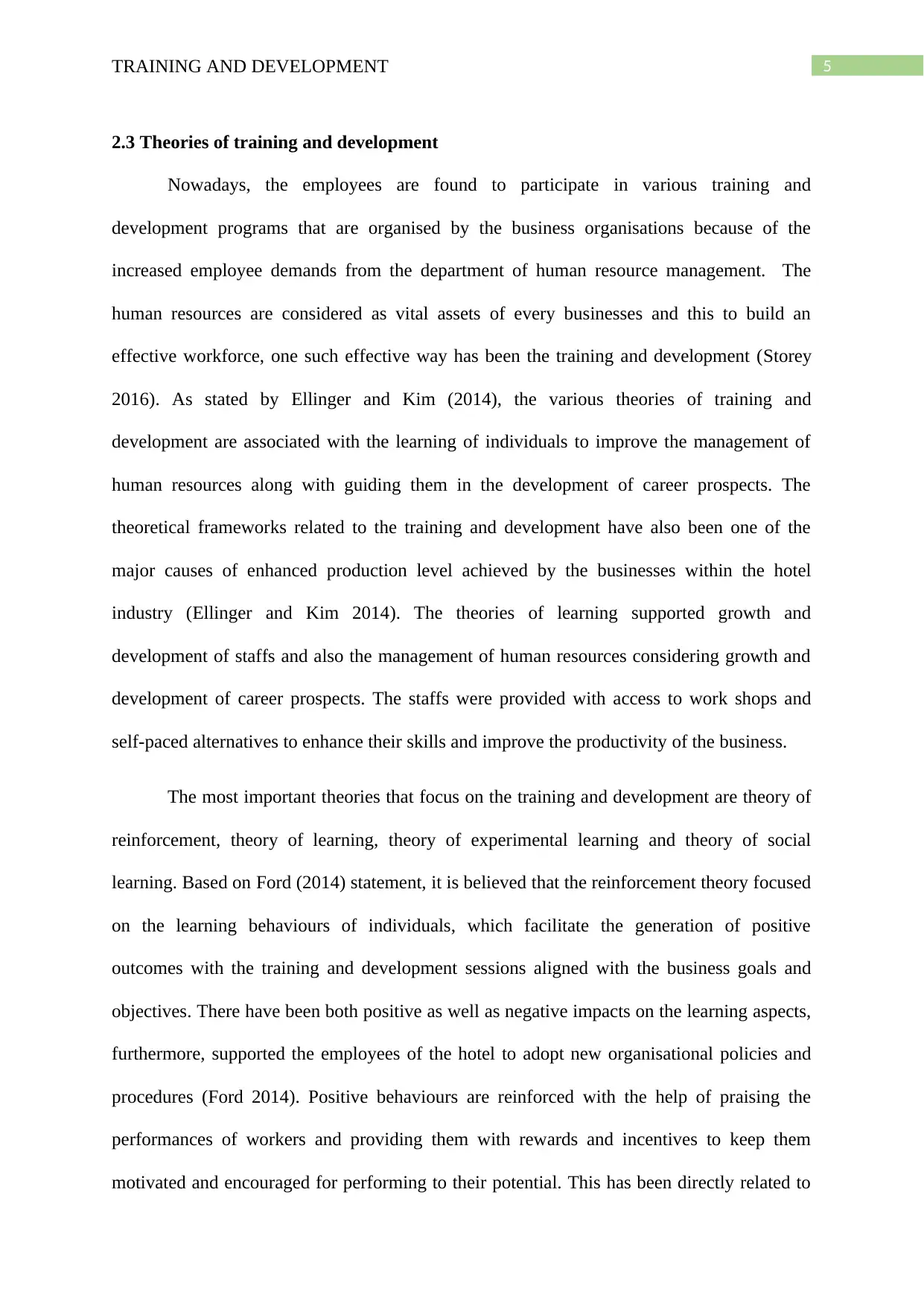
5TRAINING AND DEVELOPMENT
2.3 Theories of training and development
Nowadays, the employees are found to participate in various training and
development programs that are organised by the business organisations because of the
increased employee demands from the department of human resource management. The
human resources are considered as vital assets of every businesses and this to build an
effective workforce, one such effective way has been the training and development (Storey
2016). As stated by Ellinger and Kim (2014), the various theories of training and
development are associated with the learning of individuals to improve the management of
human resources along with guiding them in the development of career prospects. The
theoretical frameworks related to the training and development have also been one of the
major causes of enhanced production level achieved by the businesses within the hotel
industry (Ellinger and Kim 2014). The theories of learning supported growth and
development of staffs and also the management of human resources considering growth and
development of career prospects. The staffs were provided with access to work shops and
self-paced alternatives to enhance their skills and improve the productivity of the business.
The most important theories that focus on the training and development are theory of
reinforcement, theory of learning, theory of experimental learning and theory of social
learning. Based on Ford (2014) statement, it is believed that the reinforcement theory focused
on the learning behaviours of individuals, which facilitate the generation of positive
outcomes with the training and development sessions aligned with the business goals and
objectives. There have been both positive as well as negative impacts on the learning aspects,
furthermore, supported the employees of the hotel to adopt new organisational policies and
procedures (Ford 2014). Positive behaviours are reinforced with the help of praising the
performances of workers and providing them with rewards and incentives to keep them
motivated and encouraged for performing to their potential. This has been directly related to
2.3 Theories of training and development
Nowadays, the employees are found to participate in various training and
development programs that are organised by the business organisations because of the
increased employee demands from the department of human resource management. The
human resources are considered as vital assets of every businesses and this to build an
effective workforce, one such effective way has been the training and development (Storey
2016). As stated by Ellinger and Kim (2014), the various theories of training and
development are associated with the learning of individuals to improve the management of
human resources along with guiding them in the development of career prospects. The
theoretical frameworks related to the training and development have also been one of the
major causes of enhanced production level achieved by the businesses within the hotel
industry (Ellinger and Kim 2014). The theories of learning supported growth and
development of staffs and also the management of human resources considering growth and
development of career prospects. The staffs were provided with access to work shops and
self-paced alternatives to enhance their skills and improve the productivity of the business.
The most important theories that focus on the training and development are theory of
reinforcement, theory of learning, theory of experimental learning and theory of social
learning. Based on Ford (2014) statement, it is believed that the reinforcement theory focused
on the learning behaviours of individuals, which facilitate the generation of positive
outcomes with the training and development sessions aligned with the business goals and
objectives. There have been both positive as well as negative impacts on the learning aspects,
furthermore, supported the employees of the hotel to adopt new organisational policies and
procedures (Ford 2014). Positive behaviours are reinforced with the help of praising the
performances of workers and providing them with rewards and incentives to keep them
motivated and encouraged for performing to their potential. This has been directly related to
⊘ This is a preview!⊘
Do you want full access?
Subscribe today to unlock all pages.

Trusted by 1+ million students worldwide
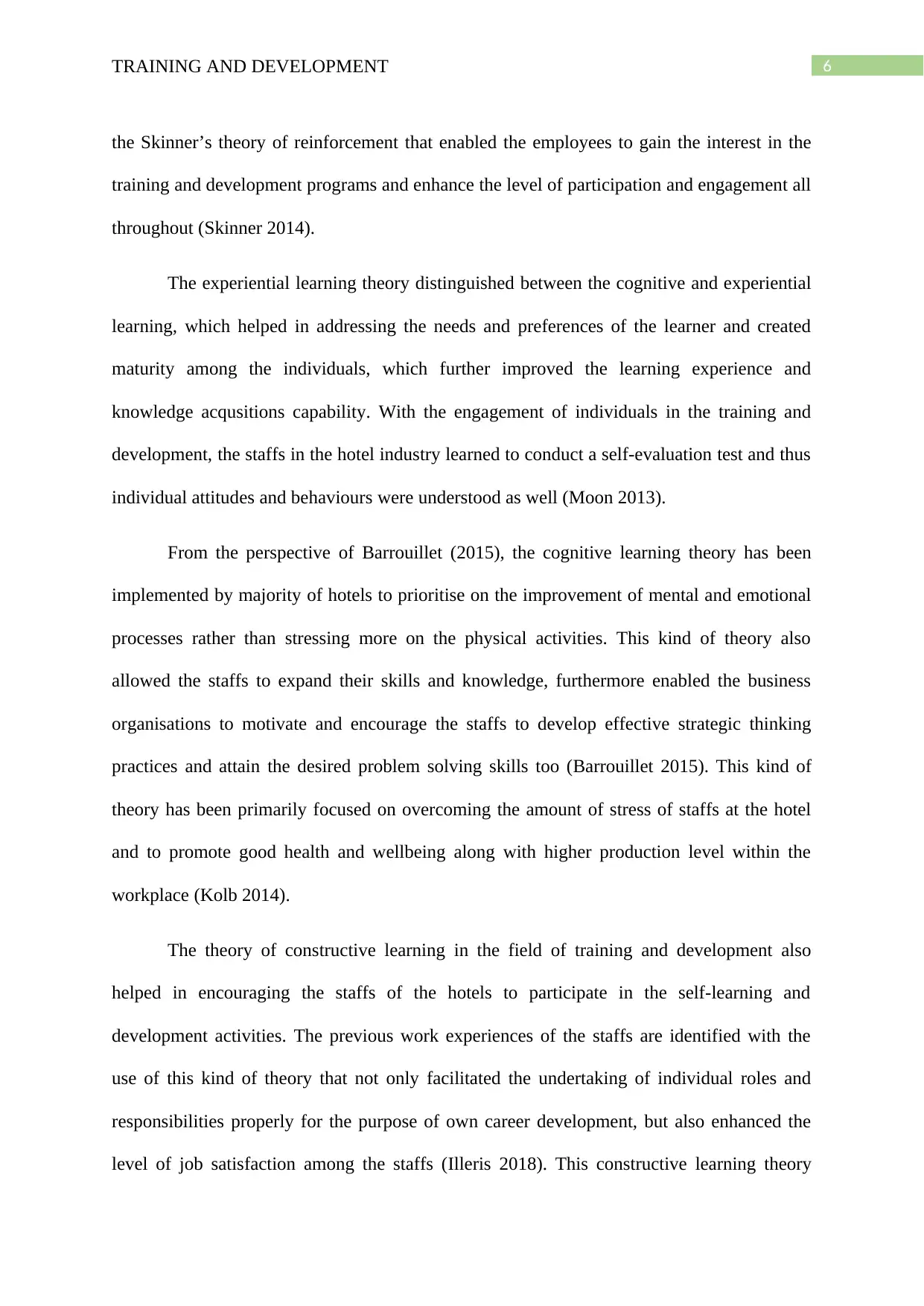
6TRAINING AND DEVELOPMENT
the Skinner’s theory of reinforcement that enabled the employees to gain the interest in the
training and development programs and enhance the level of participation and engagement all
throughout (Skinner 2014).
The experiential learning theory distinguished between the cognitive and experiential
learning, which helped in addressing the needs and preferences of the learner and created
maturity among the individuals, which further improved the learning experience and
knowledge acqusitions capability. With the engagement of individuals in the training and
development, the staffs in the hotel industry learned to conduct a self-evaluation test and thus
individual attitudes and behaviours were understood as well (Moon 2013).
From the perspective of Barrouillet (2015), the cognitive learning theory has been
implemented by majority of hotels to prioritise on the improvement of mental and emotional
processes rather than stressing more on the physical activities. This kind of theory also
allowed the staffs to expand their skills and knowledge, furthermore enabled the business
organisations to motivate and encourage the staffs to develop effective strategic thinking
practices and attain the desired problem solving skills too (Barrouillet 2015). This kind of
theory has been primarily focused on overcoming the amount of stress of staffs at the hotel
and to promote good health and wellbeing along with higher production level within the
workplace (Kolb 2014).
The theory of constructive learning in the field of training and development also
helped in encouraging the staffs of the hotels to participate in the self-learning and
development activities. The previous work experiences of the staffs are identified with the
use of this kind of theory that not only facilitated the undertaking of individual roles and
responsibilities properly for the purpose of own career development, but also enhanced the
level of job satisfaction among the staffs (Illeris 2018). This constructive learning theory
the Skinner’s theory of reinforcement that enabled the employees to gain the interest in the
training and development programs and enhance the level of participation and engagement all
throughout (Skinner 2014).
The experiential learning theory distinguished between the cognitive and experiential
learning, which helped in addressing the needs and preferences of the learner and created
maturity among the individuals, which further improved the learning experience and
knowledge acqusitions capability. With the engagement of individuals in the training and
development, the staffs in the hotel industry learned to conduct a self-evaluation test and thus
individual attitudes and behaviours were understood as well (Moon 2013).
From the perspective of Barrouillet (2015), the cognitive learning theory has been
implemented by majority of hotels to prioritise on the improvement of mental and emotional
processes rather than stressing more on the physical activities. This kind of theory also
allowed the staffs to expand their skills and knowledge, furthermore enabled the business
organisations to motivate and encourage the staffs to develop effective strategic thinking
practices and attain the desired problem solving skills too (Barrouillet 2015). This kind of
theory has been primarily focused on overcoming the amount of stress of staffs at the hotel
and to promote good health and wellbeing along with higher production level within the
workplace (Kolb 2014).
The theory of constructive learning in the field of training and development also
helped in encouraging the staffs of the hotels to participate in the self-learning and
development activities. The previous work experiences of the staffs are identified with the
use of this kind of theory that not only facilitated the undertaking of individual roles and
responsibilities properly for the purpose of own career development, but also enhanced the
level of job satisfaction among the staffs (Illeris 2018). This constructive learning theory
Paraphrase This Document
Need a fresh take? Get an instant paraphrase of this document with our AI Paraphraser
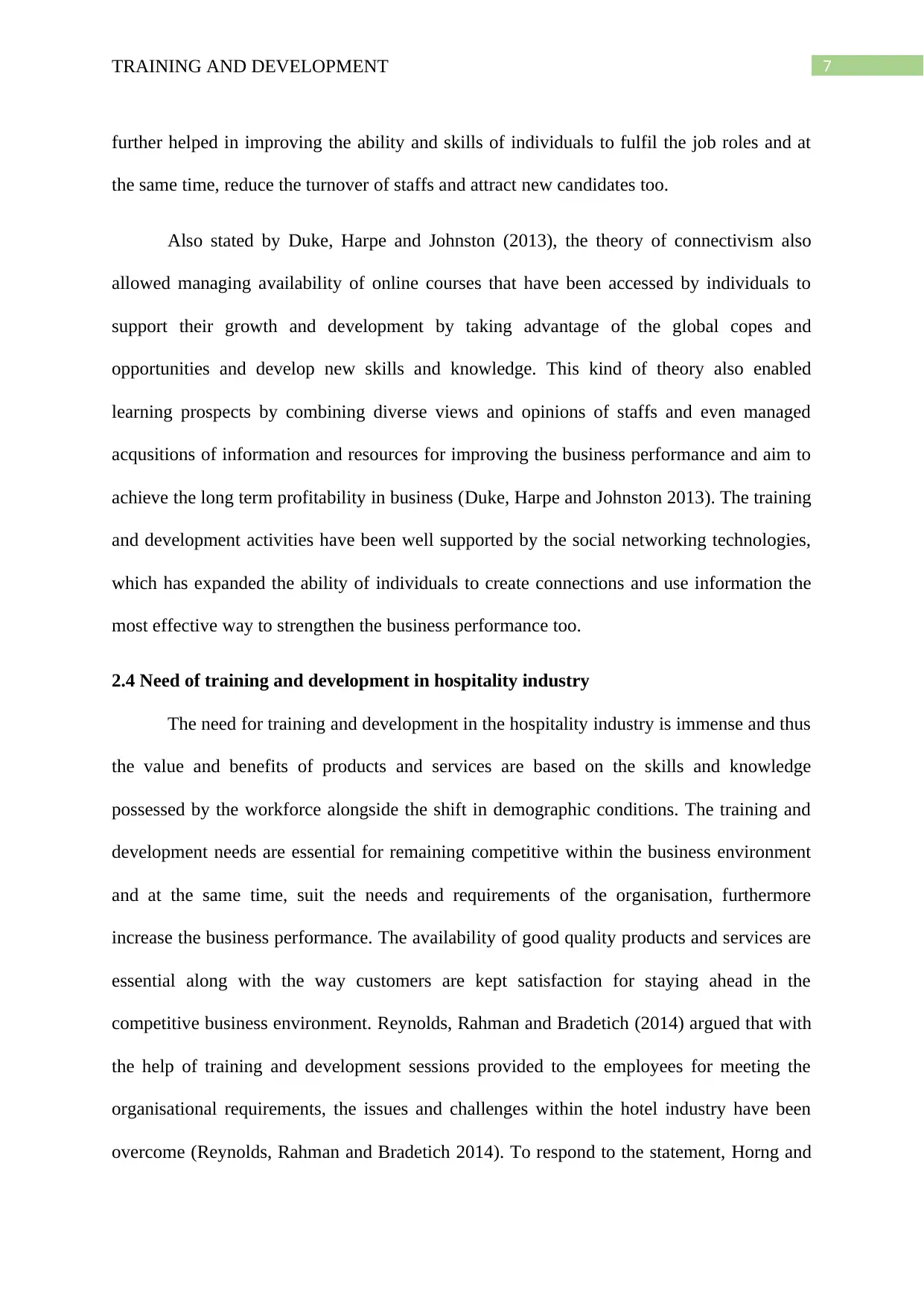
7TRAINING AND DEVELOPMENT
further helped in improving the ability and skills of individuals to fulfil the job roles and at
the same time, reduce the turnover of staffs and attract new candidates too.
Also stated by Duke, Harpe and Johnston (2013), the theory of connectivism also
allowed managing availability of online courses that have been accessed by individuals to
support their growth and development by taking advantage of the global copes and
opportunities and develop new skills and knowledge. This kind of theory also enabled
learning prospects by combining diverse views and opinions of staffs and even managed
acqusitions of information and resources for improving the business performance and aim to
achieve the long term profitability in business (Duke, Harpe and Johnston 2013). The training
and development activities have been well supported by the social networking technologies,
which has expanded the ability of individuals to create connections and use information the
most effective way to strengthen the business performance too.
2.4 Need of training and development in hospitality industry
The need for training and development in the hospitality industry is immense and thus
the value and benefits of products and services are based on the skills and knowledge
possessed by the workforce alongside the shift in demographic conditions. The training and
development needs are essential for remaining competitive within the business environment
and at the same time, suit the needs and requirements of the organisation, furthermore
increase the business performance. The availability of good quality products and services are
essential along with the way customers are kept satisfaction for staying ahead in the
competitive business environment. Reynolds, Rahman and Bradetich (2014) argued that with
the help of training and development sessions provided to the employees for meeting the
organisational requirements, the issues and challenges within the hotel industry have been
overcome (Reynolds, Rahman and Bradetich 2014). To respond to the statement, Horng and
further helped in improving the ability and skills of individuals to fulfil the job roles and at
the same time, reduce the turnover of staffs and attract new candidates too.
Also stated by Duke, Harpe and Johnston (2013), the theory of connectivism also
allowed managing availability of online courses that have been accessed by individuals to
support their growth and development by taking advantage of the global copes and
opportunities and develop new skills and knowledge. This kind of theory also enabled
learning prospects by combining diverse views and opinions of staffs and even managed
acqusitions of information and resources for improving the business performance and aim to
achieve the long term profitability in business (Duke, Harpe and Johnston 2013). The training
and development activities have been well supported by the social networking technologies,
which has expanded the ability of individuals to create connections and use information the
most effective way to strengthen the business performance too.
2.4 Need of training and development in hospitality industry
The need for training and development in the hospitality industry is immense and thus
the value and benefits of products and services are based on the skills and knowledge
possessed by the workforce alongside the shift in demographic conditions. The training and
development needs are essential for remaining competitive within the business environment
and at the same time, suit the needs and requirements of the organisation, furthermore
increase the business performance. The availability of good quality products and services are
essential along with the way customers are kept satisfaction for staying ahead in the
competitive business environment. Reynolds, Rahman and Bradetich (2014) argued that with
the help of training and development sessions provided to the employees for meeting the
organisational requirements, the issues and challenges within the hotel industry have been
overcome (Reynolds, Rahman and Bradetich 2014). To respond to the statement, Horng and
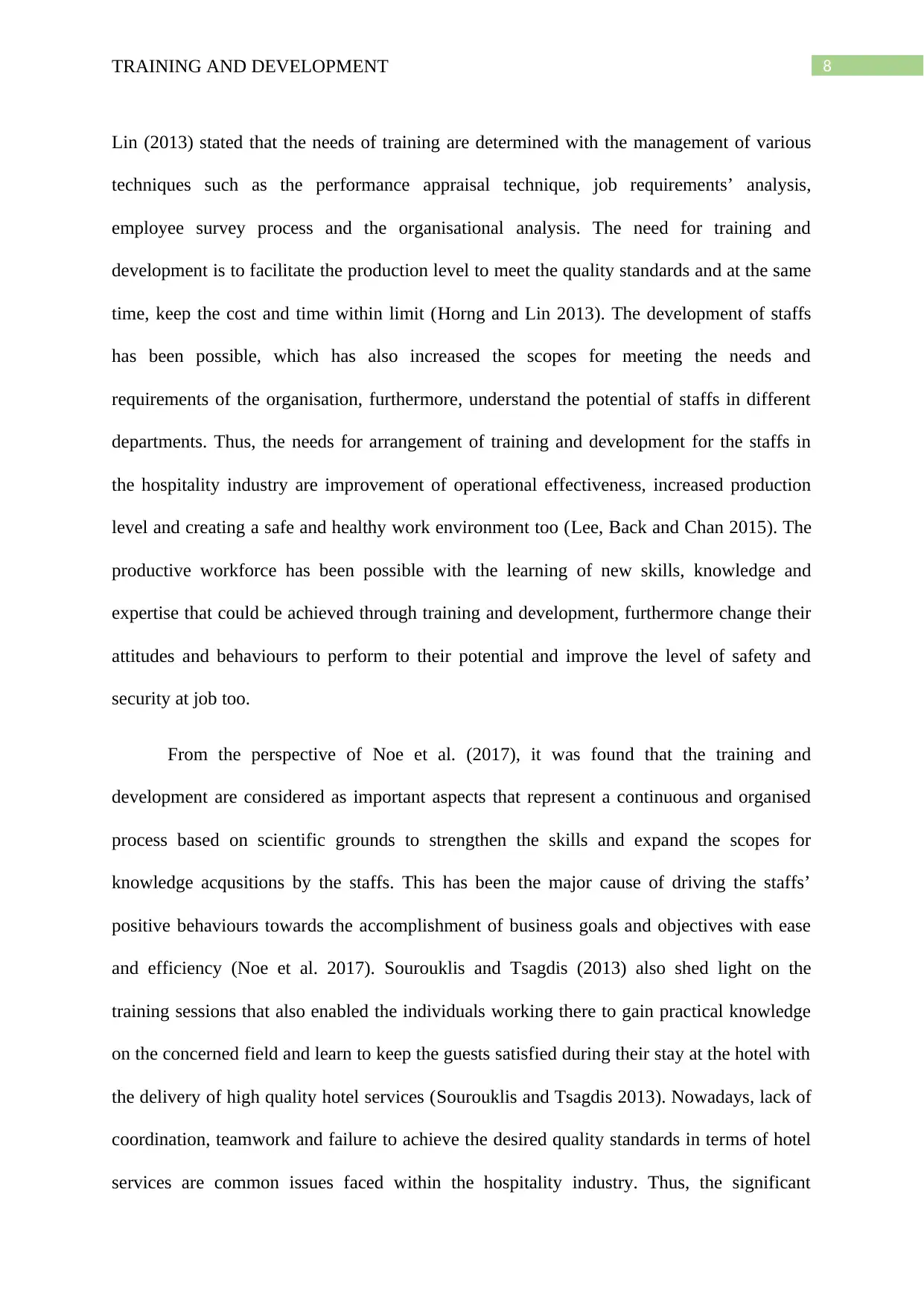
8TRAINING AND DEVELOPMENT
Lin (2013) stated that the needs of training are determined with the management of various
techniques such as the performance appraisal technique, job requirements’ analysis,
employee survey process and the organisational analysis. The need for training and
development is to facilitate the production level to meet the quality standards and at the same
time, keep the cost and time within limit (Horng and Lin 2013). The development of staffs
has been possible, which has also increased the scopes for meeting the needs and
requirements of the organisation, furthermore, understand the potential of staffs in different
departments. Thus, the needs for arrangement of training and development for the staffs in
the hospitality industry are improvement of operational effectiveness, increased production
level and creating a safe and healthy work environment too (Lee, Back and Chan 2015). The
productive workforce has been possible with the learning of new skills, knowledge and
expertise that could be achieved through training and development, furthermore change their
attitudes and behaviours to perform to their potential and improve the level of safety and
security at job too.
From the perspective of Noe et al. (2017), it was found that the training and
development are considered as important aspects that represent a continuous and organised
process based on scientific grounds to strengthen the skills and expand the scopes for
knowledge acqusitions by the staffs. This has been the major cause of driving the staffs’
positive behaviours towards the accomplishment of business goals and objectives with ease
and efficiency (Noe et al. 2017). Sourouklis and Tsagdis (2013) also shed light on the
training sessions that also enabled the individuals working there to gain practical knowledge
on the concerned field and learn to keep the guests satisfied during their stay at the hotel with
the delivery of high quality hotel services (Sourouklis and Tsagdis 2013). Nowadays, lack of
coordination, teamwork and failure to achieve the desired quality standards in terms of hotel
services are common issues faced within the hospitality industry. Thus, the significant
Lin (2013) stated that the needs of training are determined with the management of various
techniques such as the performance appraisal technique, job requirements’ analysis,
employee survey process and the organisational analysis. The need for training and
development is to facilitate the production level to meet the quality standards and at the same
time, keep the cost and time within limit (Horng and Lin 2013). The development of staffs
has been possible, which has also increased the scopes for meeting the needs and
requirements of the organisation, furthermore, understand the potential of staffs in different
departments. Thus, the needs for arrangement of training and development for the staffs in
the hospitality industry are improvement of operational effectiveness, increased production
level and creating a safe and healthy work environment too (Lee, Back and Chan 2015). The
productive workforce has been possible with the learning of new skills, knowledge and
expertise that could be achieved through training and development, furthermore change their
attitudes and behaviours to perform to their potential and improve the level of safety and
security at job too.
From the perspective of Noe et al. (2017), it was found that the training and
development are considered as important aspects that represent a continuous and organised
process based on scientific grounds to strengthen the skills and expand the scopes for
knowledge acqusitions by the staffs. This has been the major cause of driving the staffs’
positive behaviours towards the accomplishment of business goals and objectives with ease
and efficiency (Noe et al. 2017). Sourouklis and Tsagdis (2013) also shed light on the
training sessions that also enabled the individuals working there to gain practical knowledge
on the concerned field and learn to keep the guests satisfied during their stay at the hotel with
the delivery of high quality hotel services (Sourouklis and Tsagdis 2013). Nowadays, lack of
coordination, teamwork and failure to achieve the desired quality standards in terms of hotel
services are common issues faced within the hospitality industry. Thus, the significant
⊘ This is a preview!⊘
Do you want full access?
Subscribe today to unlock all pages.

Trusted by 1+ million students worldwide
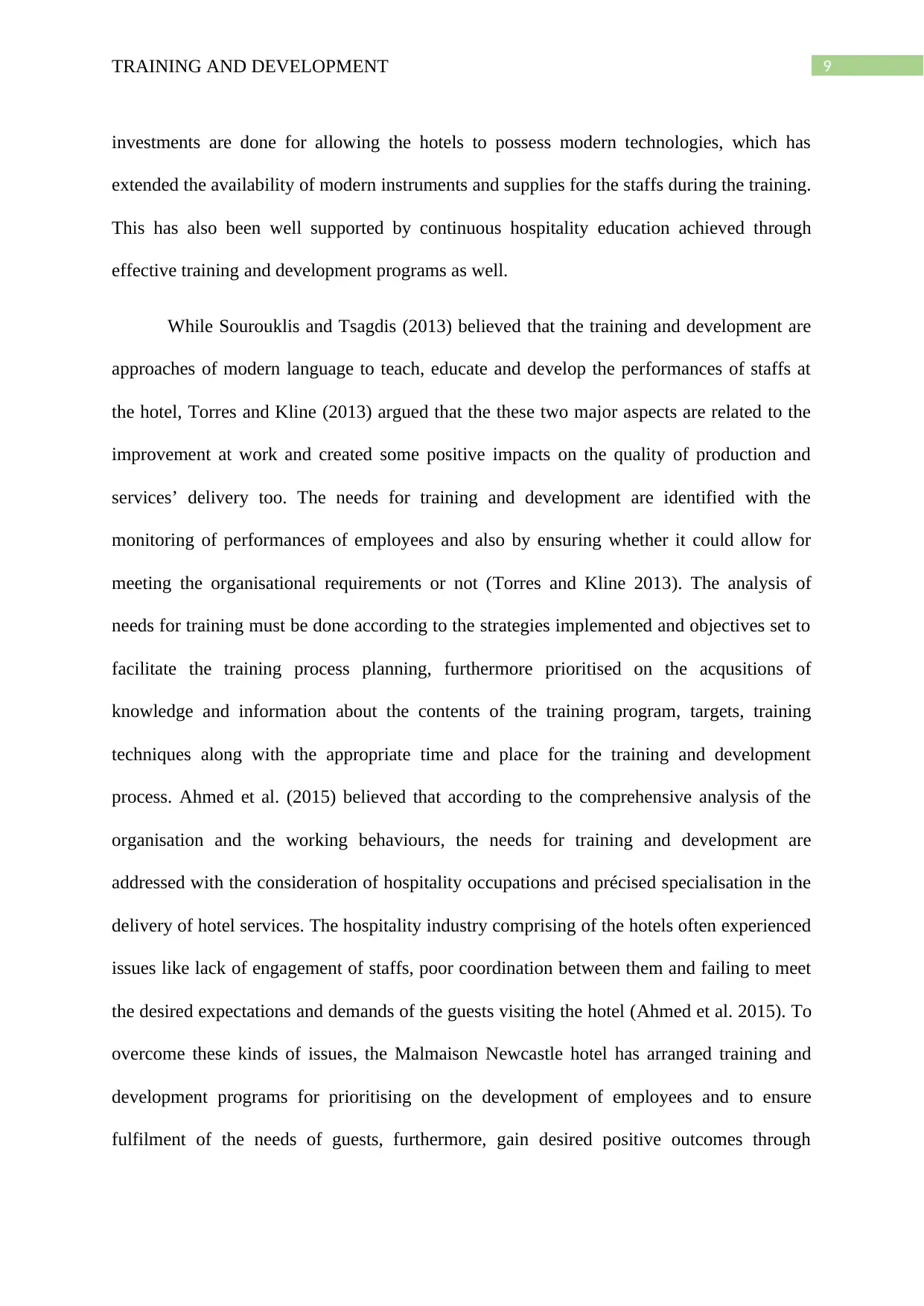
9TRAINING AND DEVELOPMENT
investments are done for allowing the hotels to possess modern technologies, which has
extended the availability of modern instruments and supplies for the staffs during the training.
This has also been well supported by continuous hospitality education achieved through
effective training and development programs as well.
While Sourouklis and Tsagdis (2013) believed that the training and development are
approaches of modern language to teach, educate and develop the performances of staffs at
the hotel, Torres and Kline (2013) argued that the these two major aspects are related to the
improvement at work and created some positive impacts on the quality of production and
services’ delivery too. The needs for training and development are identified with the
monitoring of performances of employees and also by ensuring whether it could allow for
meeting the organisational requirements or not (Torres and Kline 2013). The analysis of
needs for training must be done according to the strategies implemented and objectives set to
facilitate the training process planning, furthermore prioritised on the acqusitions of
knowledge and information about the contents of the training program, targets, training
techniques along with the appropriate time and place for the training and development
process. Ahmed et al. (2015) believed that according to the comprehensive analysis of the
organisation and the working behaviours, the needs for training and development are
addressed with the consideration of hospitality occupations and précised specialisation in the
delivery of hotel services. The hospitality industry comprising of the hotels often experienced
issues like lack of engagement of staffs, poor coordination between them and failing to meet
the desired expectations and demands of the guests visiting the hotel (Ahmed et al. 2015). To
overcome these kinds of issues, the Malmaison Newcastle hotel has arranged training and
development programs for prioritising on the development of employees and to ensure
fulfilment of the needs of guests, furthermore, gain desired positive outcomes through
investments are done for allowing the hotels to possess modern technologies, which has
extended the availability of modern instruments and supplies for the staffs during the training.
This has also been well supported by continuous hospitality education achieved through
effective training and development programs as well.
While Sourouklis and Tsagdis (2013) believed that the training and development are
approaches of modern language to teach, educate and develop the performances of staffs at
the hotel, Torres and Kline (2013) argued that the these two major aspects are related to the
improvement at work and created some positive impacts on the quality of production and
services’ delivery too. The needs for training and development are identified with the
monitoring of performances of employees and also by ensuring whether it could allow for
meeting the organisational requirements or not (Torres and Kline 2013). The analysis of
needs for training must be done according to the strategies implemented and objectives set to
facilitate the training process planning, furthermore prioritised on the acqusitions of
knowledge and information about the contents of the training program, targets, training
techniques along with the appropriate time and place for the training and development
process. Ahmed et al. (2015) believed that according to the comprehensive analysis of the
organisation and the working behaviours, the needs for training and development are
addressed with the consideration of hospitality occupations and précised specialisation in the
delivery of hotel services. The hospitality industry comprising of the hotels often experienced
issues like lack of engagement of staffs, poor coordination between them and failing to meet
the desired expectations and demands of the guests visiting the hotel (Ahmed et al. 2015). To
overcome these kinds of issues, the Malmaison Newcastle hotel has arranged training and
development programs for prioritising on the development of employees and to ensure
fulfilment of the needs of guests, furthermore, gain desired positive outcomes through
Paraphrase This Document
Need a fresh take? Get an instant paraphrase of this document with our AI Paraphraser
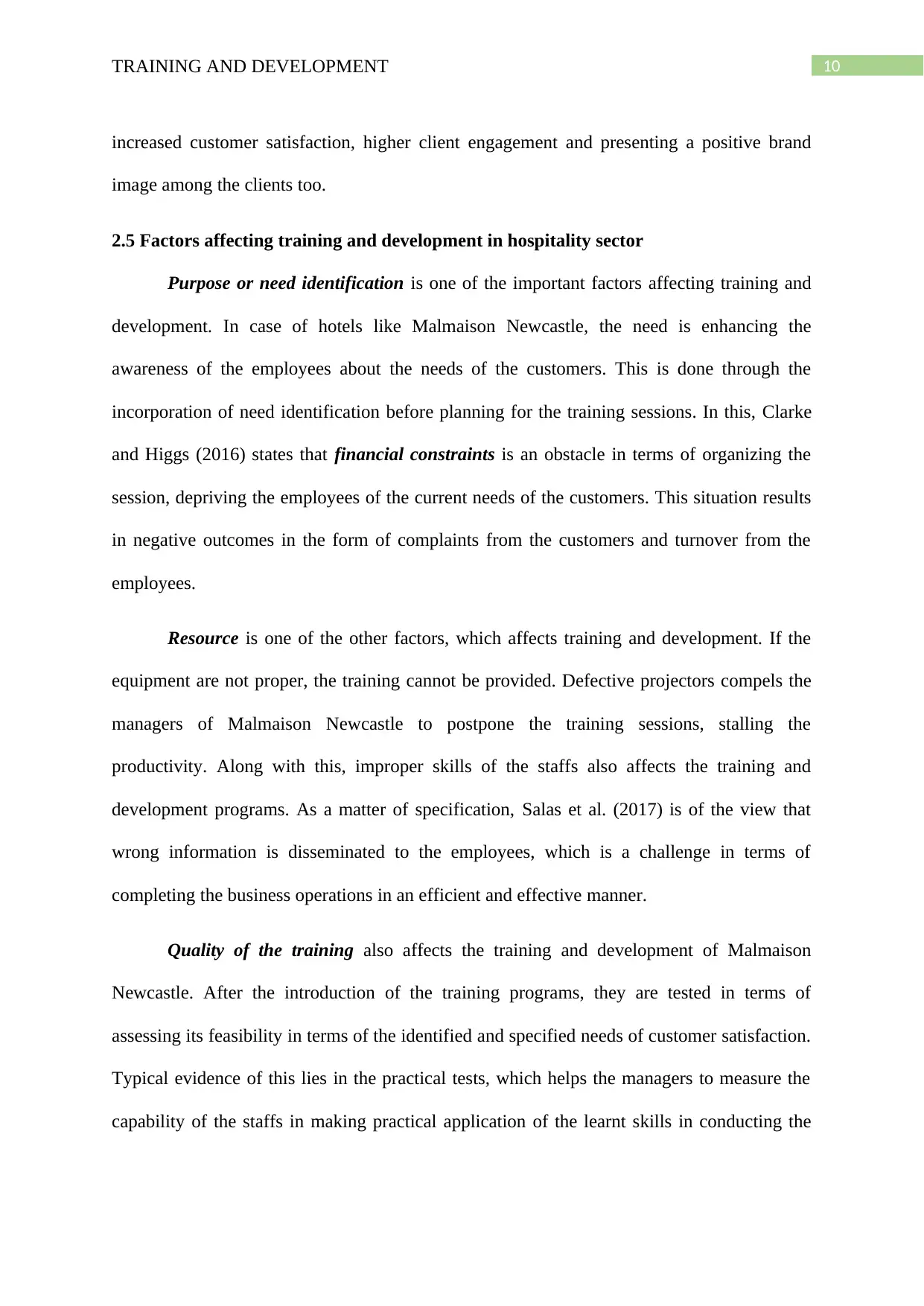
10TRAINING AND DEVELOPMENT
increased customer satisfaction, higher client engagement and presenting a positive brand
image among the clients too.
2.5 Factors affecting training and development in hospitality sector
Purpose or need identification is one of the important factors affecting training and
development. In case of hotels like Malmaison Newcastle, the need is enhancing the
awareness of the employees about the needs of the customers. This is done through the
incorporation of need identification before planning for the training sessions. In this, Clarke
and Higgs (2016) states that financial constraints is an obstacle in terms of organizing the
session, depriving the employees of the current needs of the customers. This situation results
in negative outcomes in the form of complaints from the customers and turnover from the
employees.
Resource is one of the other factors, which affects training and development. If the
equipment are not proper, the training cannot be provided. Defective projectors compels the
managers of Malmaison Newcastle to postpone the training sessions, stalling the
productivity. Along with this, improper skills of the staffs also affects the training and
development programs. As a matter of specification, Salas et al. (2017) is of the view that
wrong information is disseminated to the employees, which is a challenge in terms of
completing the business operations in an efficient and effective manner.
Quality of the training also affects the training and development of Malmaison
Newcastle. After the introduction of the training programs, they are tested in terms of
assessing its feasibility in terms of the identified and specified needs of customer satisfaction.
Typical evidence of this lies in the practical tests, which helps the managers to measure the
capability of the staffs in making practical application of the learnt skills in conducting the
increased customer satisfaction, higher client engagement and presenting a positive brand
image among the clients too.
2.5 Factors affecting training and development in hospitality sector
Purpose or need identification is one of the important factors affecting training and
development. In case of hotels like Malmaison Newcastle, the need is enhancing the
awareness of the employees about the needs of the customers. This is done through the
incorporation of need identification before planning for the training sessions. In this, Clarke
and Higgs (2016) states that financial constraints is an obstacle in terms of organizing the
session, depriving the employees of the current needs of the customers. This situation results
in negative outcomes in the form of complaints from the customers and turnover from the
employees.
Resource is one of the other factors, which affects training and development. If the
equipment are not proper, the training cannot be provided. Defective projectors compels the
managers of Malmaison Newcastle to postpone the training sessions, stalling the
productivity. Along with this, improper skills of the staffs also affects the training and
development programs. As a matter of specification, Salas et al. (2017) is of the view that
wrong information is disseminated to the employees, which is a challenge in terms of
completing the business operations in an efficient and effective manner.
Quality of the training also affects the training and development of Malmaison
Newcastle. After the introduction of the training programs, they are tested in terms of
assessing its feasibility in terms of the identified and specified needs of customer satisfaction.
Typical evidence of this lies in the practical tests, which helps the managers to measure the
capability of the staffs in making practical application of the learnt skills in conducting the
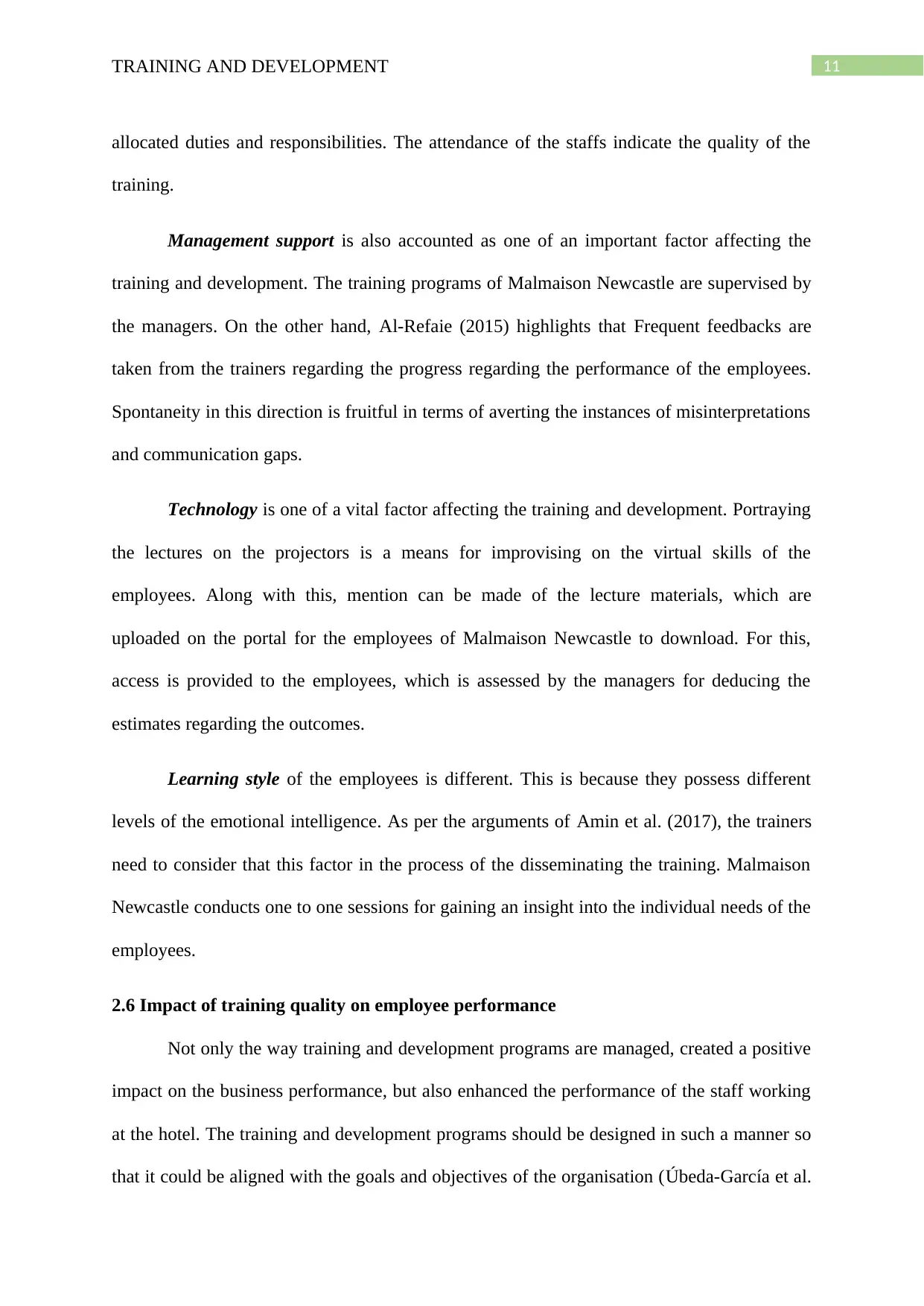
11TRAINING AND DEVELOPMENT
allocated duties and responsibilities. The attendance of the staffs indicate the quality of the
training.
Management support is also accounted as one of an important factor affecting the
training and development. The training programs of Malmaison Newcastle are supervised by
the managers. On the other hand, Al-Refaie (2015) highlights that Frequent feedbacks are
taken from the trainers regarding the progress regarding the performance of the employees.
Spontaneity in this direction is fruitful in terms of averting the instances of misinterpretations
and communication gaps.
Technology is one of a vital factor affecting the training and development. Portraying
the lectures on the projectors is a means for improvising on the virtual skills of the
employees. Along with this, mention can be made of the lecture materials, which are
uploaded on the portal for the employees of Malmaison Newcastle to download. For this,
access is provided to the employees, which is assessed by the managers for deducing the
estimates regarding the outcomes.
Learning style of the employees is different. This is because they possess different
levels of the emotional intelligence. As per the arguments of Amin et al. (2017), the trainers
need to consider that this factor in the process of the disseminating the training. Malmaison
Newcastle conducts one to one sessions for gaining an insight into the individual needs of the
employees.
2.6 Impact of training quality on employee performance
Not only the way training and development programs are managed, created a positive
impact on the business performance, but also enhanced the performance of the staff working
at the hotel. The training and development programs should be designed in such a manner so
that it could be aligned with the goals and objectives of the organisation (Úbeda-García et al.
allocated duties and responsibilities. The attendance of the staffs indicate the quality of the
training.
Management support is also accounted as one of an important factor affecting the
training and development. The training programs of Malmaison Newcastle are supervised by
the managers. On the other hand, Al-Refaie (2015) highlights that Frequent feedbacks are
taken from the trainers regarding the progress regarding the performance of the employees.
Spontaneity in this direction is fruitful in terms of averting the instances of misinterpretations
and communication gaps.
Technology is one of a vital factor affecting the training and development. Portraying
the lectures on the projectors is a means for improvising on the virtual skills of the
employees. Along with this, mention can be made of the lecture materials, which are
uploaded on the portal for the employees of Malmaison Newcastle to download. For this,
access is provided to the employees, which is assessed by the managers for deducing the
estimates regarding the outcomes.
Learning style of the employees is different. This is because they possess different
levels of the emotional intelligence. As per the arguments of Amin et al. (2017), the trainers
need to consider that this factor in the process of the disseminating the training. Malmaison
Newcastle conducts one to one sessions for gaining an insight into the individual needs of the
employees.
2.6 Impact of training quality on employee performance
Not only the way training and development programs are managed, created a positive
impact on the business performance, but also enhanced the performance of the staff working
at the hotel. The training and development programs should be designed in such a manner so
that it could be aligned with the goals and objectives of the organisation (Úbeda-García et al.
⊘ This is a preview!⊘
Do you want full access?
Subscribe today to unlock all pages.

Trusted by 1+ million students worldwide
1 out of 21
Related Documents
Your All-in-One AI-Powered Toolkit for Academic Success.
+13062052269
info@desklib.com
Available 24*7 on WhatsApp / Email
![[object Object]](/_next/static/media/star-bottom.7253800d.svg)
Unlock your academic potential
Copyright © 2020–2025 A2Z Services. All Rights Reserved. Developed and managed by ZUCOL.





